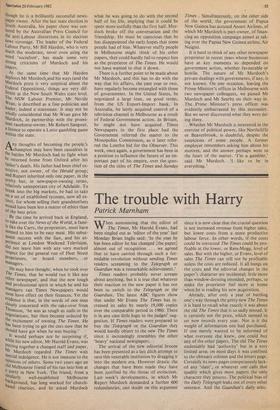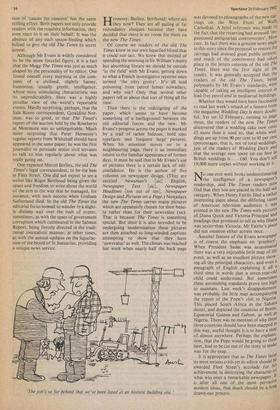The trouble with Harry
Patrick Marnham
When announcing that the editor of The Times, Mr Harold Evans, had been singled out as 'editor of the year' last Monday Brian Inglis said: 'In the year he has been editor he has changed [the paper] almost out of recognition ... we agreed that to have carried through such a for- midable revolution without sending Times readers screaming to the Telegraph or Guardian was a remarkable achievement.'
Times readers probably never scream about anything, but it is true that whatever their reaction to the new paper it has not been to switch to the Telegraph or the Guardian. The latest ABC figures show that under Mr Evans The Times has in- creased its sales by nearly 19,000 copies over the comparable period in 1980. There is in any case little logic in the judges' sug- gestion. If Times readers were prepared to buy the Telegraph or the Guardian they would hardly object to the new The Times since it increasingly resembles the other 'heavy' national newspapers.
The arrival of the new editorial broom has been presented as a last ditch attempt to save this venerable institution by dragging it into the modern era. However drastic the changes that have been made they have been justified by the threat of extinction. Last week"s developments, in which Mr Rupert Murdoch demanded a further 600 redundancies, cast doubt on this argument
since it is now clear that the crucial question is not increased revenue from higher sales, but lower costs from a more productive labour force. In other words, if the costs could be corrected The Times could be pro- fitable at the lower, or Rees-Mogg, level of sales. But with the higher, or Evans, level of sales The Times can still not be profitable unless the costs are reduced. It all hangs on the costs and the editorial changes in the paper's character are incidental; little more than window-dressing intended, perhaps, to make the proprietor feel more at home when he is reading his new acquisition.
Already, after only a year of battling one's way through the gritty new The Times it is hard to recall what exactly it was about the old The Times that is so sadly missed. It is certainly not the price, which seemed to set new records every year. Nor is it the weight of information one had purchased. If one merely wanted to be informed of what everyone else knew, one could buy any of the other papers. The old The Times undeniably had 'authority' but in a very limited area; on most days it was confined to the obituary column and the letters page. Certainly its news pages conspicuously lack- ed any 'slant', or whatever one calls that quality which gives most papers the only character they possess. The political bias of the Daily Telegraph leaks out of every other sentence. And the Guardian's daily selec-
tion of 'causes for concern' has the same stifling effect. Both papers not only provide readers with the requisite information, they
even react to it on their behalf. It was the absence of any such spoon-feeding which helped to give the old The Times its secret appeal.
Although Mr Evans is widely considered to be the more forceful figure, it is a fact that the Mogg The Times was just as much shaped by the personality of its editor. One found oneself every morning in the com- pany of a civilised, slightly barmy, humorous, usually gentle, intelligence, whose most stimulating characteristic was its unpredictability. Here was a highly peculiar view of the world's reportable events. Hardly surprising, perhaps, that the Sale Room correspondent, Geraldine Nor- -man, was so good, or that The Times's report of the auction held by the Roseberys at Mentmore was so unforgettable. Much more surprising that Peter Hennessy's regular reports from Whitehall should have appeared in the same paper; he was the first journalist to persuade senior civil servants to talk to him regularly about what was really going on.
One expected Marcel Berlins, the old The Times's legal correspondent, to be the best in Fleet Street. One did not expect to see a writer like Roger Berthoud being given the space and freedom to write about the world of the arts in the way that he managed, for instance, with such success when Graham Sutherland died. In the old The Times the editorial focus seemed to wander in a slight- ly dreamy way over the rush of events, sometimes, as with the spate of government corruption which culminated in the Salmon Report, being fiercely directed in the tradi- tional journalistic manner; at other times, as with the annual updates on the liquefac- tion of the blood of St Januarius, providing a unique news service. Hennessy, Berlins, Berthoud: where are they now? They are all gazing at fat redundancy cheques because they have decided that there is no room for them on the new The Times.
Of course we readers of the old The Times knew in our own liquefied blood that it could not last. We knew that instead of spending the morning in Sir William's musty but absorbing library we should be outside 'in the field' with Mr Evans, getting down to what a French investigative reporter once termed 'the nitty grotty'. It's all lead poisoning from petrol fumes nowadays, and why not? Only that several other papers tell us about that sort of thing all the time.
Then there is the redesigning of the paper, which seems to have become something of a battleground between the old editorial forces and the new. Mr Evans's progress across the pages is marked by a trail of rather hideous, bold sans typefaces and frequent large pictures. When his attention moves on to a neighbouring page, there is an immediate return to the familiar appearance of former days. It must be said that in Mr Evans's use of pictures there is a certain lack of self- confidence. He is the author of five volumes on newspaper design. (They are entitled Newsman's [sic] English, Newspaper Text [sic], Newspaper Headlines [ten out of ten], Newspaper Design and Pictures on a Page.) Nowadays the new The Times carries many pictures which are apparently chosen for their beau- ty rather than for their newsvalue (sic). That is because The Times is something special. But since it is also intended to be undergoing modernisation these pictures are then attached to long-winded captions attempting to show that they have 'newsvalue' as well. The climax was reached last week when nearly half the back page 'The job's so far behind that we've been listed as an historic building site.' was devoted to photographs of the new car- vings on the West Front of Wells Cathedral. A brief reference was made to the fact that the recarving had aroused 'im- passioned antiquarian controversies'. How cute. In fact there was a genuine news angle in this story since the proposal to restore the carvings had aroused great public interest, and much of the controversy• had taken place in the letters columns of the old The Times. Here was the first sight of the results. It was generally accepted that the readers of the old The Times, being polymaths by Mr Evans's standards, were capable of taking an intelligent interest in lead-free petrol and in mediaeval buildings. Whether they would have been fascinated to read last week's rehash of a feature from the magazine Wedding Day is more doubt- ful. Yet on 12 February, turning to page three, the readers of the new The Times discovered that a wedding cake now costs £5 more than it used to, that white wed- dings are up from 90 per cent to 93 per cent (percentages, that is, not of total weddings, just of the readers of Wedding Day); and that the average sum spent on car hire at British weddings is ... £60. You don't sell 19,000 more copies without working at it.
N.To one ever went broke underestimating .1 the intelligence of a newspaper's readership, and The Times readers now find that they too are placed in the half-wit category. When Henry Fairlie filed a rather interesting piece about the differing tastes of American television audiences it was printed in the new The Times with pictures of Diana Quick and Victoria Principal and headings that promised to tell us why Diana was sexier-than Victoria. Mr Fairlie's piece did not mention either actress once.
Another feature of the Evans newspaper is of course the emphasis on 'graphics When President Sadat was assassinated there was a very enjoyable little map of the event, as well as an excellent picture show- ing all the principal characters, and even a paragraph of English explaining it all a third time in words that a seven-year-old child could understand. But sometimes these astonishing standards prove too high to maintain. Last week's disappointment was probably the little map accompanying the report of the Pope's visit to Nigeria. This placed South Africa in the Sahara desert, and depicted the countries of Benin, Equatorial Guinea and Gabon, as well as Nigeria. There was no mention of why these three countries should have been mapped to this way, useful thought it is to have a map of almost anywhere. Perhaps the explana- tion, that the Pope would be going to them later, had to be cut out of the story to make way for the map. It is appropriate that as The Times faces its most serious crisis yet its editor should be awarded Fleet Street's accolade for his, achievement in destroying the character 01 what was once a remarkable newspaper. it is after all one of the most pervasive modern ideas, that death should be a 100g drawn-out process.







































 Previous page
Previous page